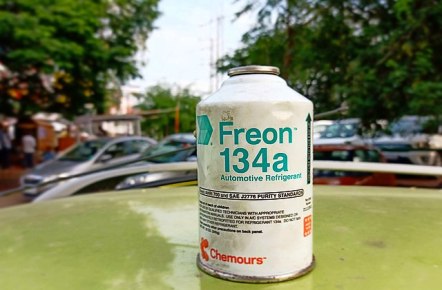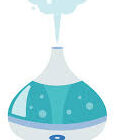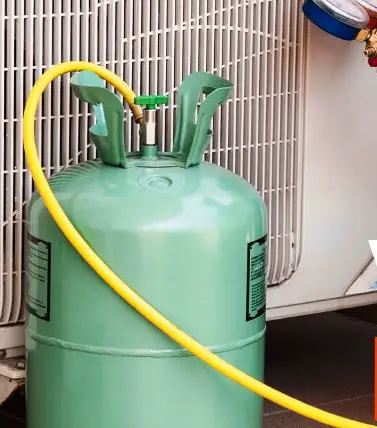What is Freon in Dehumidifiers and Why It’s Illegal!
Do humidifiers have Freon?
First, most of the dehumidifiers in the market use refrigerant to absorb the heat from the air they suck in. This causes the vapor to condense and collect in the bucket for disposal, and the now-drier air is blown back into the room.
Freon (R-22) has been used as a refrigerant in air conditioning and refrigeration systems in the past. From 2020 forward, producing or importing Freon into the United States will remain banned.
Why?
Exposure to Freon causes various health risks. For instance, because it is denser than oxygen when you inhale it, it prevents the proper uptake of oxygen from the lungs into the blood.
Freon also causes the depletion of the ozone layer. In return, this increases the risk of skin cancer because the ozone layer cannot prevent ultraviolet rays.
These are just two of the health risks that this gas poses, but ONLY IF IT LEAKS. If it stays in your compressor-type dehumidifier, it is safe. As you clean your dehumidifier coils, check for leaks.
So, back to the question: do humidifiers have Freon? The older humidifiers, probably many of them manufactured before 2020, have R-22. The latest models coming after 2020 should not contain this refrigerant. Its production or importation was banned in the same year.
What is Freon?

This is a type of refrigerant, among many others. Because of its popularity, most people started referring to any other refrigerant as Freon.
As of 2020, Freon use, manufacture, and importation into the USA remain banned. Any dehumidifier made after 2020 will not contain Freon.
Today, it might be impossible to recharge the humidifier if it has Freon, and leaks since it is no longer manufactured or imported into the USA.
Also, Freon is a toxic gas if it starts to leak from the dehumidifier coils. If it does not leak, it does not pose any risk. Don’t worry too much if you have an old dehumidifier that uses Freon.
Does my dehumidifier have Freon in it?
Most modern dehumidifiers do not contain Freon. Instead, they use R-410A or R-134a, which are more eco-friendly.
If you have an older dehumidifier, it may contain Freon. Most of them did anyway, as did air conditioners.
Also read:
Best humidifiers for hard water reviews
10 mold toxicity warning symptoms
Because Freon is no longer under production, it may be difficult or expensive to get your dehumidifier recharged if it leaks.
How do I know if my dehumidifier has Freon?
Just check the label on the unit. If it does not have one, call the manufacturer or email them.
But if it is an old, compressor-style dehumidifier made before 2020, it probably contains Freon.
Check the refrigerant type. If it says R-22, then your dehumidifier contains Freon.
If the label reads a different type of refrigerant, such as R-410A, then it does not contain Freon.
Do all dehumidifiers contain refrigerant?

Dehumidifiers contain refrigerant because of its function in the dehumidification process.
But some don’t contain refrigerants. For instance, the small dehumidifiers for 2×2 grow tents, such as the desiccant types, do not contain refrigerant.
So:
How does the dehumidifier refrigerant work?
But bigger portable units, such as the Frigidaire 70-Pint dehumidifier contain refrigerant. It cools the air, causing the moisture to condense on the refrigerant coils.
The moisture then collects in a reservoir (dehumidifier bucket) or is drained away from the unit. The refrigerant is then cycled back through the system to cool the air again.
If this process is not taking place properly, you will experience the dehumidifier blowing cold air. If it is working properly, it should blow warm air.
Why do dehumidifiers use refrigerant?
Refrigerant helps cool the air and remove moisture from it. When the warm and humid air from the room enters the dehumidifier, it passes over the refrigerant coils.
The refrigerant absorbs the heat from the air and cools it down, causing moisture to condense on the coils. The condensate then drips to a collection pan and eventually goes into the bucket. Once the bucket is full, the dehumidifier stops working until it is emptied.
If you are using a dehumidifier with a drain hose, it is going to remove the water using gravity, mostly into the sink or the garden outside. Also, in the basement, you can use a dehumidifier with a pump and drain hose to pump the water out vertically.
Refrigerant is an essential component of the dehumidification process, and it is necessary for the unit to function properly.
Please also note that not all refrigerants are created equal. Freon (R-22) is now banned because of its negative impact on the environment and human health.
Choose a dehumidifier that uses a more environmentally friendly refrigerant, such as R-410A or R-134a.
How do I know if my dehumidifier is low on Freon?
You checked the label of your dehumidifier for grow tent or basement and established that it runs on Freon.
It is not really supposed to run low on this refrigerant, but anything that can go wrong will go wrong.
So, if your unit is low on refrigerant, it may not be able to effectively remove moisture from the air. If you notice that it is hard to control humidity in the incubator, the basement, the crawl spaces, or wherever you are using it, it could have run out of Freon.
This can result in increased humidity levels and the accompanying problems. These include mold growth, which you can tell from the musty smell in your room.
Some signs that your dehumidifier may be low on refrigerant include:
The unit is running constantly
If your dehumidifier is running constantly but not lowering humidity, it may be low on refrigerant.
Air coming out of the unit is hot instead of warm
If your dehumidifier is blowing hot air, it may be a sign that the refrigerant is not cooling the air effectively. This happens because there isn’t enough refrigerant to cool the humid air passing over the coils.
The unit is making strange noises
If you hear strange noises, such as hissing or gurgling sounds, it could be a sign that there is a refrigerant leak.
You get used to the kind of noise that a dehumidifier makes after using it for some time. If this noise changes, you know it needs checking.
If you suspect that your dehumidifier is low on refrigerant, it’s important to have it inspected by a qualified technician.
They can determine whether the unit needs to be recharged with refrigerant or if there is a leak that needs to be repaired.
How to know if a dehumidifier needs to be recharged with refrigerant

If your dehumidifier is not effectively lowering humidity in the room, it may need to be recharged with refrigerant.
Not all dehumidifiers can be recharged. Some units are disposable after using all the refrigerant. Such cannot be refilled.
If you can recharge a dehumidifier, you can tell if it needs to be refilled by checking the refrigerant pressure.
It should have a gauge on the refrigerant line that shows the pressure level. If the pressure is low, it is usually an indication that the refrigerant needs refilling.
Does Freon run out?
Unlike other components in your air conditioner, Freon doesn’t get used up or consumed during the cooling process.
It is designed to remain in the system and continue to be recycled repeatedly. However, if your air conditioner is leaking Freon, then you will need to have it refilled.
And this brings us to the next question, below:
Can I refill Freon?
In 2023? It might be a bit hard because, again, the importation and production of the R-22 refrigerant have been banned since 2020.
Before you dispose of the dehumidifier, please contact a professional HVAC technician for a proper diagnosis.
They will determine if there is a leak, where it is, and how much Freon they need to add. Some HVAC repair companies still have Freon from before the ban, so yes, it is possible to refill the Freon.
Under no circumstances should you do this on your own because it is dangerous and requires specialized equipment and skill to do so safely.
Remember, it is also illegal to refill your Freon without proper certification.
Wrapping Up
Dehumidifiers and air conditioners use similar technology to cool and dehumidify the air. But they do not always use the same refrigerants.
In most cases, dehumidifiers use a refrigerant called R-410A, which is a hydrofluorocarbon refrigerant that does not contain chlorine.
It is an eco-friendly alternative to CFCs and HCFCs, and it does not contribute to ozone depletion.
Older dehumidifiers made before 2020 come with a refrigerant called Freon. Despite its serious implications for the environment and health, there is really nothing to worry about if your dehumidifier runs on Freon. It is safe if there is no leakage.

